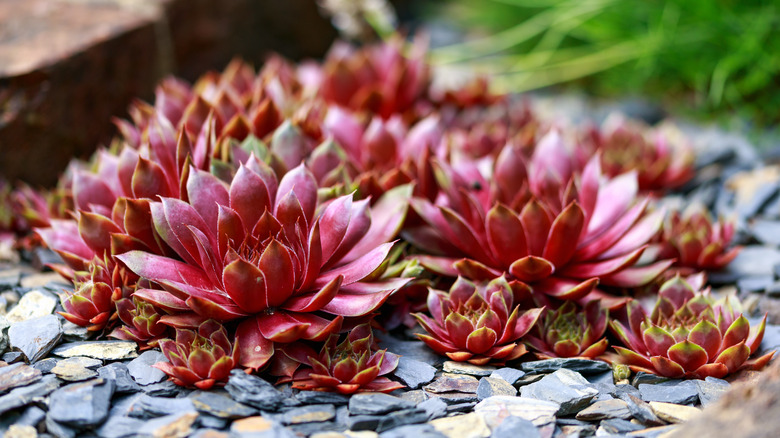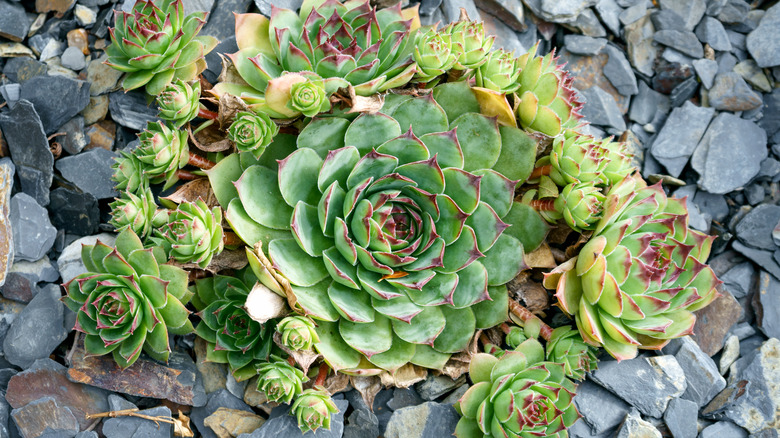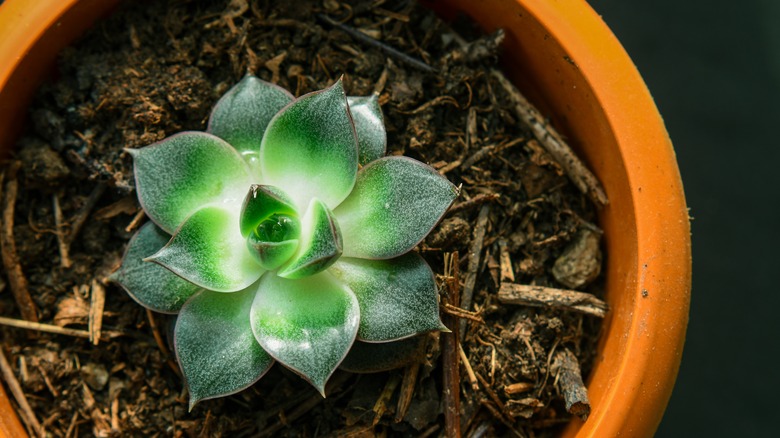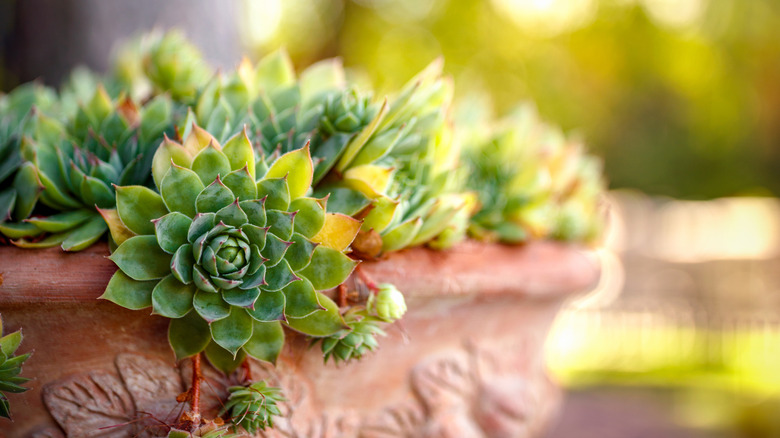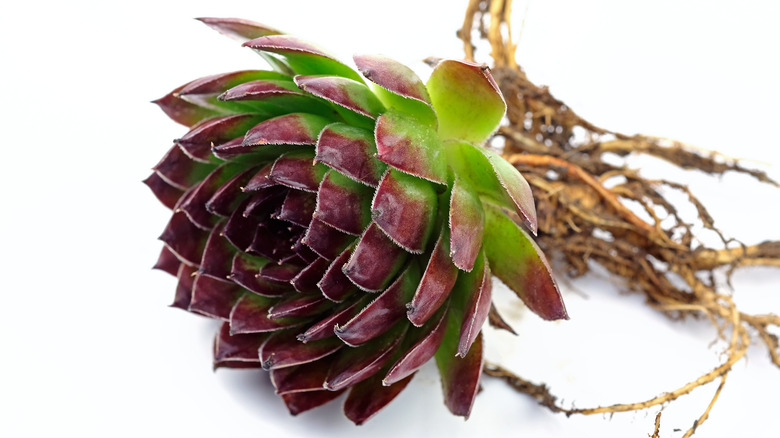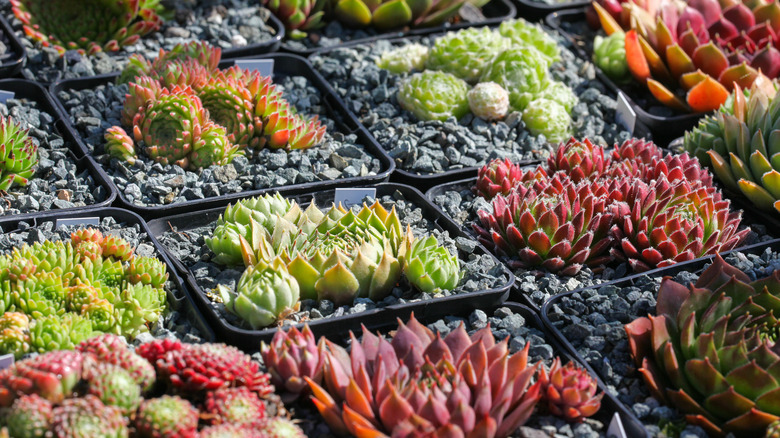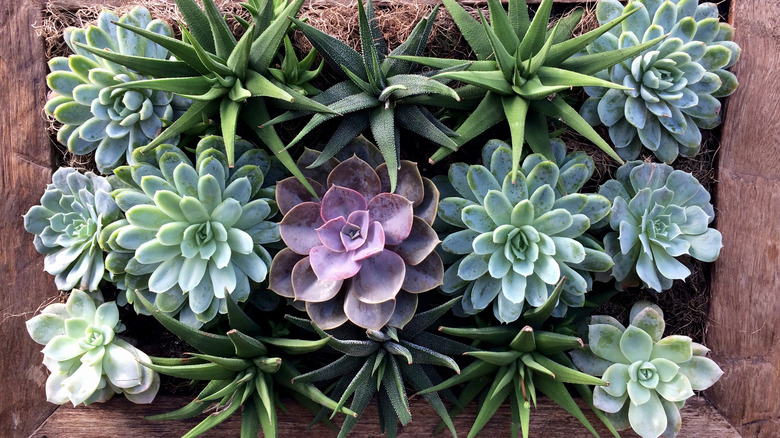How To Care For A House Leek Plant
The genus Sempervivum (also known as the houseleek plant) has been given the nickname of "live-forever" due to its resilience and strength, according to Britannica. The houseleek plant also goes by other names as well, such as hens-and-chicks, due to its rosette shape similar to the bottom of a hen and its ability to create multiple hatchlings (via Gardening Know How). The houseleek is also known to come in multiple beautiful colors such as white, pink, or purple. Due to changing weather patterns, their colors can change as well: Houseleeks can be pink in the spring and then green in the fall, notes Mountain Crest Gardens.
The houseleek is originally from Central and Southern Europe, as well as the Greek islands, according to World of Succulents. In the past, these plants would typically be found on the roof of a house. It was believed that the houseleek plant could protect someone's home from fires, lightning, and witchcraft while also keeping occupants safe. The protection from houseleeks was so widely believed that even the Holy Roman Emperor Charlemagne declared his subjects in 742 AD to grow them on their roofs for protection.
How to use houseleek in garden
Thanks to the durability of a houseleek, they can be planted almost anywhere — especially places where other plants would instead wither away, according to NC State University. Planting locations are endless; trays, containers, rock piles, dish gardens, terrariums, and other hardy surfaces such as seashells. Some common ideas of how to style your houseleek in your garden include placing them down as garden borders and rock gardens — which is especially useful to those who live in a very warm climate (Britannica). A beautiful and unique way for those new to growing houseleeks is planting your houseleeks in a triple pot. As long as the soil is rough and is able to drain well, the houseleeks should then be able to thrive and grow together in this layered pot that may remind you of cake, according to Richard Jackson Garden.
For those more advanced who may want to stay within the traditional route: planting houseleeks on your roof is still common practice. Some people in the United Kingdom still use houseleeks as a method of filling in holes on their roofs. It can be an interesting look as the plant grows across your roof and collects water from the rain to prevent leakage into your home.
How to grow a houseleek
According to the World of Succulents, unlike other household plants, houseleeks do not need to be watered every day. In fact, gardeners should let the roots of their houseleeks dry before watering them again. When planting a houseleek, it is also important to keep the hole shallow and also spread out the roots before covering the houseleek with soil up to its crown. It should also be noted that packing the soil gently is necessary to ensure that the plant is firmly in the ground.
Houseleeks can also be planted in a soil gravel mix by laying out seeds onto the surface, which then need to be kept wet until they begin to sprout: fine gravel is also laid out on as mulch afterward. These plants should always start their life out in a pot before being transferred to a garden as a seedling. This can typically be successful during the fall and spring seasons.
How to care for houseleeks
These plants are pretty easy to maintain, especially in hot and dry environments, and you don't even need to give them much water at all, says World of Succulents. However, this plant still has some pretty specific needs. Houseleek plants enjoy temperatures between 60 and 75 degrees. If temperatures drastically change, the plant can stop growing and become comatose.
Houseleeks also require sunlight every day, as well as soil that can drain at a moderate rate. This is important as it can prevent pests and diseases. These plants can sometimes suffer from crown rot when in wet soil, which can produce a fungus disease. If kept in dry conditions, these problems can be prevented. Another benefit to caring for a houseleek is they do not need fertilizer, as it is accustomed to growing in substandard soils and rocky surfaces, according to Cactusway. However, for those who would like to grow their houseleek quickly, they can feed it diluted fertilizer in early spring.
How to repot houseleek
Once you've grown your houseleek for a while and desire a new look, you may decide to repot it somewhere else. Before removing your plant from its pot, the soil must be dry, according to World of Succulents. The next step is to remove any dirt or rotted and dead roots to be sure that the plant is ready for its fresh, dry, and drained soil. You must hold back and keep your plant dry for a week before you begin to sparingly water it to prevent root rot.
Once your houseleek begins flowering, don't stress if your houseleek dies soon after. However, since the plant has been producing seeds around it, you will then quickly be welcomed by her offsets (also known as pups), and they then will continue the vegetation process. Be sure that the offsets are about half of the mother plants' size before removing them (via Harddy). It is important then to cut the offsets off with a pair of prunes and then repot them into a fresh bed of soil. Be sure to place them in a dark area and avoid giving them water until they have placed their roots in the soil. If you have followed this process correctly, you could end up with six to eight new houseleeks.
Houseleek varieties
Houseleeks are part of a decently sized family of sempervivums, according to Balcony Web Garden. These colorful evergreen succulents have varieties that differ in mass, shape, and color. This list from Balcony Web Garden contains over 30 varieties, so let's take a look at a few of them.
- The sempervivum 'fashion diva' is a plant that likes to show off its red color that contrasts beautifully with hues of yellow and green.
- Sempervivum ciliosum is a considered to be one of the most favorable varieties to plant and grow in a garden.
- The sempervivum 'raspberry ice' is an award-winning plant which took home the Sempervivum Society's Silver Rosette Award in 1978.
- Sempervivum arachnoideum 'cobweb houseleek' is a unique and scary plant that is covered in cobwebs.
- Sempervivum 'commander hay' is similar to that of a watermelon with its green tips and purple-red leaves are seen in the interior.
Are houseleeks toxic?
Houseleek plants are known to be safe around pets and children, as Plant Care Today tells it. In fact, houseleeks are an excellent way to stay healthy and refreshed. Some people include the thick leaves and young shoots of the plant in their raw food diets. This plant is consistent with a slightly sour taste and is reminiscent of a cucumber. Those who suffer from skin irritation have also noted that houseleeks can be used as a substitution for aloe vera — which is known to contain toxins. This is because of the water that is stored in the plant.
Although houseleek plants aren't dangerous, there are thousands of succulents that people can mistake them for. If you're unsure of what plant you are handling, be sure to wear gloves and long sleeve shirts to avoid skin irritation. It is also wise to hesitate burning any unknown plant that could possibly release toxic substances into the air.
